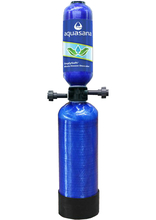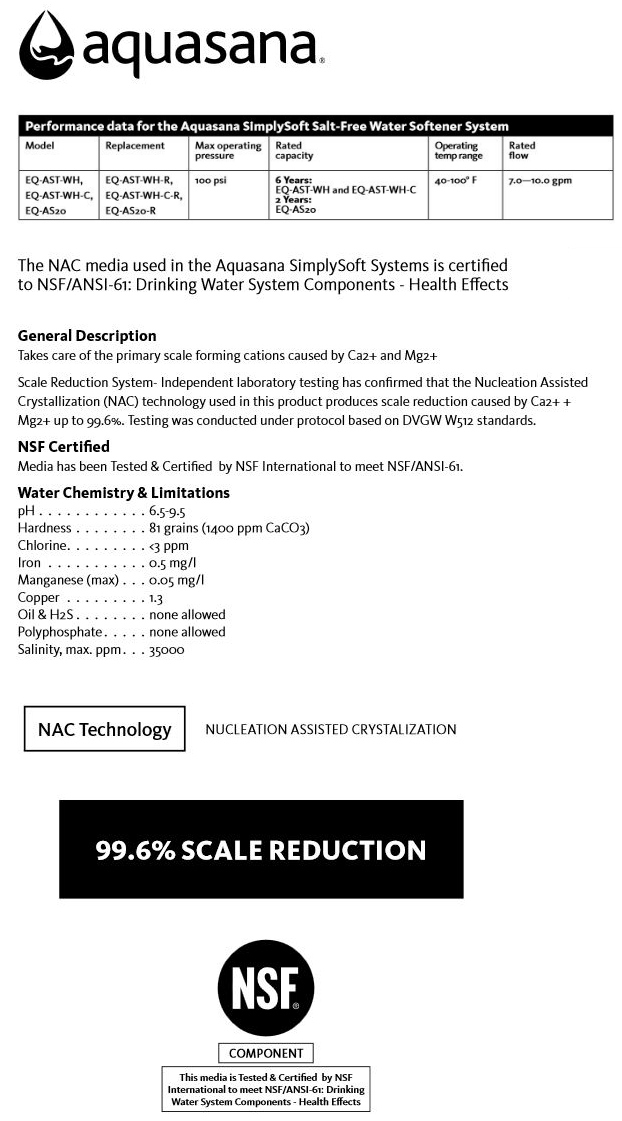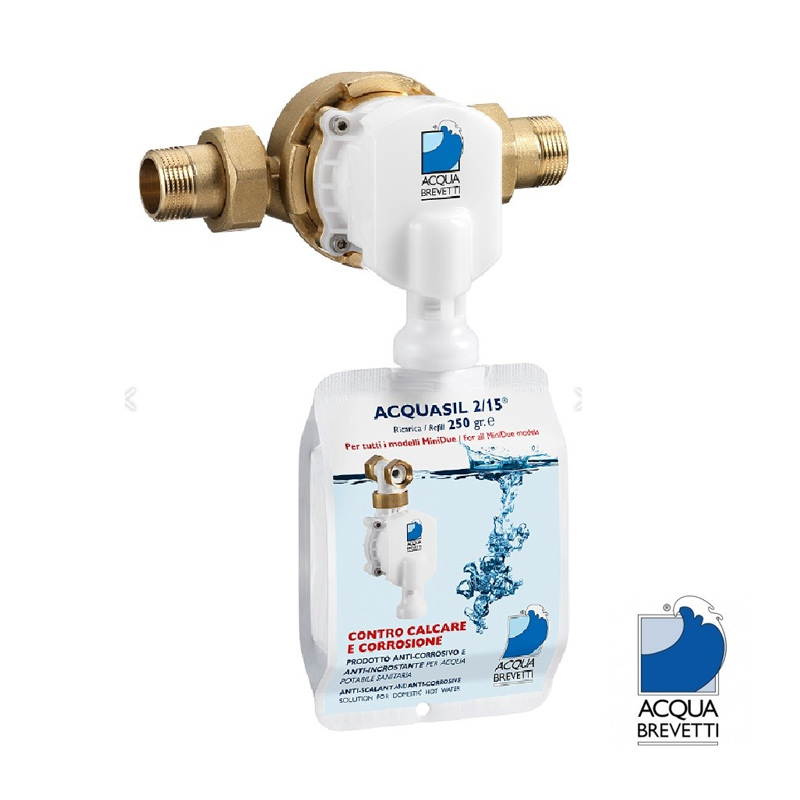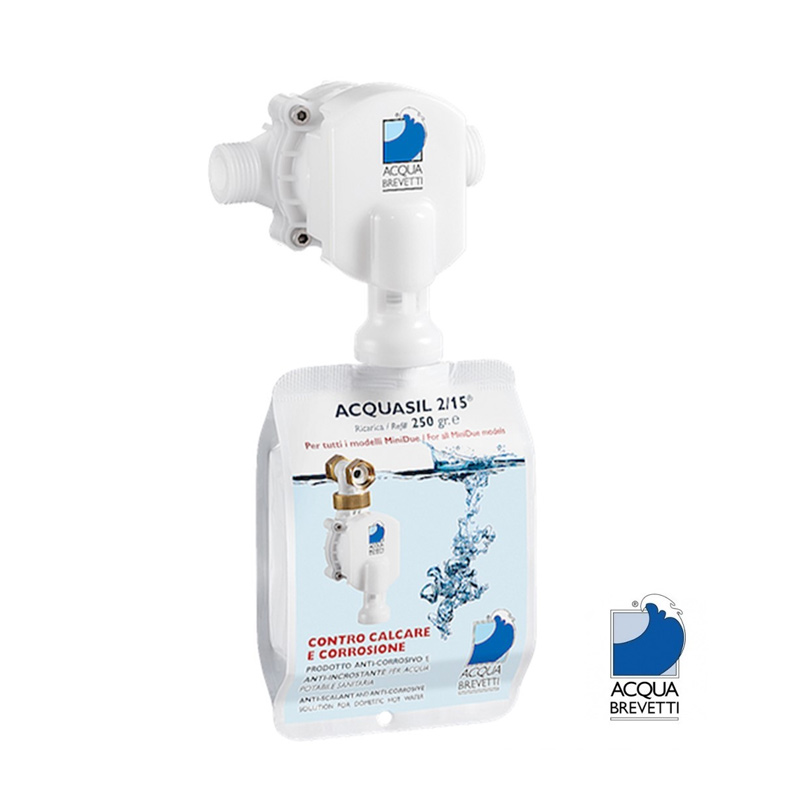Whole House Filters


Product Description
Effective, Eco-friendly scale prevention for the entire house without the use of harsh chemicals or salt for 6 Years Maintenance Free!
The Aquasana SimplySoft Whole House dual tank system is designed to hook up seamlessly with your whole house water filter system. Protect your home appliances and plumbing by reducing the adverse effects of excess iron and scale. Be free of scale, stains and spots on faucets, shower heads and glassware. Never lug around heavy bags of salt again. Unlike traditional salt-based softeners, SimplySoft does not require salt, electricity or drainage for wastewater. More than just a softener, Aquasana SimplySoft uses innovative Nucleation Assisted Crystallization (NAC) softening technology to naturally condition your water without the use of added sodium. NAC technology alters the structure of the hard minerals into a crystal structure that prevents the minerals from binding and forming scale build-up and is proven to reduce scale by up to 99.6%.
Key Features of the Aquasana SimplySoft Salt Free Whole House Water Softener- Eco-friendly Salt Free Softener Solution - SimplySoft won't demineralize your water by chemically removing minerals nor will it put excess salt waste or chemicals into our environment.
- Protect your home appliances and plumbing from the adverse effects of scale buildup.
- Extend the life of your washing machine, water heater, dishwasher and other appliances.
- Eliminate scale build-up and filmy residue that causes staining and spotting on tableware, clothing, shower heads and faucets.
- Maintenance free for 6 years!
SimplySoft Whole House Performance
Innovative Salt-Free Softening Technology
NSF Certified NAC media technology naturally and safely alters the structure of hard mineral ions into a crystal structure that prevents the minerals from binding and forming scale build-up. NAC salt-free softening is proven to reduce scale by up to 99.6%. Unlike salt-based water softeners, Aquasana SimplySoft will not demineralize your water nor will it negatively affect the environment by adding excessive amounts of sodium waste into our communal water system. Nucleation Assisted Crystallization (NAC) technology naturally and effectively inhibits scale buildup by transforming dissolved hard minerals into harmless, inactive microscopic crystal particles that are harmlessly passed through your water and down the drain.
Independently tested by DVGW to Standard W-512 to reduce scale by 99.6%.
Aquasana SimplySoft uses advanced NSF Certified NAC salt-free softening technology to naturally and safely reduce scale buildup in hard water without the use of salt or chemicals.

Product Code: PM011
Connections - ¾” M DN
Minimum flow rate - 0.24m3/h
Flow rate (P=0.2 bar) - 1.3m3/h
Flow rate (P=0.5 bar) - 1.8m3/h
Min-max water hardness - 5 - 35°f
Max. instantaneous heating temperature - 80°C
Max temperature for stored hot water - 60°C
250 gr refill autonomy - 10 - 11m3
1000 gr refill autonomy - 40 - 44m3
Min-max water pressure - 1.5 - 6bar
Min-max water temperature inside MiniDUE - 5 - 30°C
Dimensions
Width (A) -164mm
Total height (B) - 94mm
Height at connection (C) - 56mm
Distance from ground (D) - 300mm
Depth (E) - 103mm
Acqua Brevetti MiniDUE ½″ Liquid Water Softener
✓ Prevents limescale build up and corrosion for whole house or individual appliances
✓ Brilliant Eco alternative to a traditional Water Softener
✓ No electricity, no waste and easy maintenance
✓ Ideal for confined spaces
The Acqua Brevetti MiniDUE ½″ Liquid Water Softener
is a compact volumetric proportional mechanical dosing pump water
softening system designed to fit onto ¾″' (22mm copper or speedfit)
pipes. The system simply fits onto the rising main pipe or any pipe
supplying a particular device, such as a boiler.
The MiniDUE adds
the precise dosage of AcquaSIL 2/15® Liquid to water. AcquaSIL is a
100% safe, food grade polyphosphate used specifically for the treatment
of drinking water. MiniDUE provides limescale prevention and corrosion
prevention within the systems such as boilers, heaters, showers, taps,
radiators, coffee machines, all plumbing fixtures and so on.
The
MineDUE is a great alternative to a water softener due to it being very
easy to install and to maintain as replacing the pouches is very simple
and quick. The system takes up very little space compared to a
traditional softener and the cost of maintenance is lower too.
The
MiniDue is an eco-friendly alternative to a water softener as no water
is wasted; as softeners uses thousands of litres every month to
regenerate the resin - there is no need with this innovative and space
saving device. It also uses no electricity and overall the system is a
great innovation in the water treatment industry.
How Does MiniDUE Work
MiniDUE
is a self-priming mechanical volumetric pump that is operated by a
turbine which in turn transmits the movement to a special cam shaft that
enables the liquid to rise from the refil pouch to the injection valve,
where it is injected a small amount of AcquaSIL 2/15® Liquid into the
water as it passes through the pipe. The liquid comes in pouches (sold
in 250gram and 1000gram variants) that clip onto the system, which makes
changing them very easy. The system comes with a remote installation
kit, a 250gram refill, an installation manual and a warranty form.
MiniDUE
is available as standard with ½″ Male connections.and can be installed
on a horizontal or vertical pipe by simply adjusting the orientation of
the connection block. For whole house protection you can use our larger
refill pouch of 1000gram which provides up to 44 cubic meters of dosage
(44,000 litres) from a single pouch.
Because MiniDUE uses a
liquid solution we guarantee a sludge free operation. MiniDUE is fully
compliant with European Approval EU 98/83/CE for use with drinking
water. and is approved by the Italian water quality approval board under
DM, no. 174, 06.04.04. The Use of AcquaSIL and specifically the use of
Polyphosphates is covered by the standard UNI 8065, part 5.4.1 which
indicates the use of polyphosphates for the treatment of scale deposits
and corrosion.
Features
Totally mechanically operated, no power required.
Absolute and real precise proportional dosage of liquid polyphosphate AcquaSil 2/15®.
Self-priming.
Miniaturized in minimal size dosing station suitable for household applications.
Remote installation availability. The flexible bag can be installed separately from the dosing pump, when
spaces do not allow the jointly installation.
Versatile. The pump can be oriented in all directions, just turning it; no need to reverse or disassembly its
own parts.
No need to put in by pass or drain the system during refill operations; just replace the flexible bag.
Non return valve integrated resistant to water counter pressure.
For the first time suitable also for protection of recessed boilers!, where spaces are very restricted.
About refill
Under-vacuum suction
Flexible disposable refill bags
Can be jointly or remotely to the pump be installed
Two different sizes available (250 gr. or 1000 gr, for increasing the autonomy)
Completely isolated from hydraulic circuit
The advantages of the Under-Vacuum suction and disposable refills!
Hygienic advantages. No direct handling form end user.
No periodic tank cleaning operations required.
Effective preservation of polyphosphate quality.
No evaporation of product, avoiding water concentration reduction in the liquid solution.
No atmospheric contamination.

Connections - ½” Male BSP on inlet & outlet ports (ideal for 15mm pipe)
Minimum flow rate - 0.18 m3/h
Flow rate (at 0.2 bar) - 0.6 m3/h (600 LPH)
Flow rate (at 0.5 bar) - 1.0 m3/h (1000 LPH)
Min-max water hardness - 5 - 35°f
Max. instantaneous heating temperature - 80°C
Max temperature for stored hot water - 60°C
250 gr refill capacity - 10-11 m3 (10,000 to 11,000 litres)
1000 gr refill autonomy - 40-44 m3 (40,000 to 44,000 litres)
Min-max water pressure - 1.5 - 6 bar
Min-max water temperature inside MiniDUE - 5 - 30°C
Description
Acqua Brevetti MiniDUE ½″ Liquid Water Softener
✓ Prevents limescale build up and corrosion for whole house or individual appliances
✓ Brilliant Eco alternative to a traditional Water Softener
✓ No electricity, no waste and easy maintenance
✓ Ideal for confined spaces
The
Acqua Brevetti MiniDUE ½″ Liquid Water Softener is a compact volumetric
proportional mechanical dosing pump water softening system designed to
fit onto ½″' (15mm copper or speedfit) pipes. The system simply fits
onto the rising main pipe or any pipe supplying a particular device,
such as a boiler.
The MiniDUE adds the precise dosage of AcquaSIL
2/15® Liquid to water. AcquaSIL is a 100% safe, food grade
polyphosphate used specifically for the treatment of drinking water.
MiniDUE provides limescale prevention and corrosion prevention within
the systems such as boilers, heaters, showers, taps, radiators, coffee
machines, all plumbing fixtures and so on.
The MineDUE is a
great alternative to a water softener due to it being very easy to
install and to maintain as replacing the pouches is very simple and
quick. The system takes up very little space compared to a traditional
softener as well and the cost of maintenance is lower too.
The
MiniDue is an eco-friendly alternative to a water softener as no water
is wasted; as softeners uses thousands of litres every month to
regenerate the resin - there is no need with this innovative and space
saving device. It also uses no electricity and overall the system is a
great innovation in the water treatment industry.
How Does MiniDUE Work
MiniDUE
is a self-priming mechanical volumetric pump that is operated by a
turbine which in turn transmits the movement to a special cam shaft that
enables the liquid to rise from the refil pouch to the injection valve,
where it is injected a small amount of AcquaSIL 2/15® Liquid into the
water as it passes through the pipe. The liquid comes in pouches (sold
in 250gram and 1000gram variants) that clip onto the system, which makes
changing them very easy. The system comes with a remote installation
kit, a 250gram refill, an installation manual and a warranty form.
MiniDUE
is available as standard with ½″ Male connections.and can be installed
on a horizontal or vertical pipe by simply adjusting the orientation of
the connection block. For whole house protection you can use our larger
refill pouch of 1000gram which provides up to 44 cubic meters of dosage
(44,000 litres) from a single pouch.
Because MiniDUE uses a
liquid solution we guarantee a sludge free operation. MiniDUE is fully
compliant with European Approval EU 98/83/CE for use with drinking
water. and is approved by the Italian water quality approval board under
DM, no. 174, 06.04.04. The Use of AcquaSIL and specifically the use of
Polyphosphates is covered by the standard UNI 8065, part 5.4.1 which
indicates the use of polyphosphates for the treatment of scale deposits
and corrosion.
Features
Totally mechanically operated, no power required.
Absolute and real precise proportional dosage of liquid polyphosphate AcquaSil 2/15®.
Self-priming.
Miniaturized in minimal size dosing station suitable for household applications.
Remote installation availability. The flexible bag can be installed separately from the dosing pump, when
spaces do not allow the jointly installation.
Versatile. The pump can be oriented in all directions, just turning it; no need to reverse or disassembly its
own parts.
No need to put in by pass or drain the system during refill operations; just replace the flexible bag.
Non return valve integrated resistant to water counter pressure.
For the first time suitable also for protection of recessed boilers!, where spaces are very restricted.
About refill
Under-vacuum suction
Flexible disposable refill bags
Can be jointly or remotely to the pump be installed
Two different sizes available (250 gr. or 1000 gr, for increasing the autonomy)
Completely isolated from hydraulic circuit
The advantages of the Under-Vacuum suction and disposable refills!
Hygienic advantages. No direct handling form end user.
No periodic tank cleaning operations required.
Effective preservation of polyphosphate quality.
No evaporation of product, avoiding water concentration reduction in the liquid solution.
No atmospheric contamination.
Water conditioning has become a nebulous term over the years. To customers, it may mean softening, filtration, scale prevention, contaminant removal or all of the above. In modern water treatment, though, it is the term used when there is a need for scale control and prevention. With the complexities of water quality, increasing contaminant issues and differing opinions on technologies, it has become harder to define what types of systems are included under the umbrella of water conditioning.
Water Conditioning for Scale Control
In regard to scale control and prevention, there is a general consensus it is divided into two categories: traditional and non-traditional. Traditional water conditioning has enjoyed a long-standing track record—polyphosphates date back to the early 19th century—and includes proven and tested methods, such as ion exchange water softening, polyphosphate scale inhibitors and oxidation-reduction.
Ion exchange is the go-to method for water softening, but it has come under fire for wasting water and discharging salt into the environment. Consequently, manufacturers are developing improvements to increase efficiency and reduce these impacts. According to the Water Quality Assn., “A 2009 study commissioned by the Water Quality Research Foundation and conducted by the Battelle Memorial Institute found that adding a water softener helps water heaters and major appliances operate as efficiently as possible, while preventing clogs in showerheads, faucets and drains.”
Phosphates as a reliable scale inhibitor water conditioner include crystallized forms, as well as a more recently developed version called Siliphos. According to Aquachemix, the U.K. agent for Siliphos for the past 40 years, it acts as a “threshold inhibitor” in sub-stoichiometric amounts, stabilizing water and preventing CaCO3 scale from forming. As a guideline, it can prevent CaCO3 scaling up to a water hardness of 360 ppm CaCO3 and withstand a water temperature up to 80°C by sequestering hardness minerals and preventing the formation of limescale deposits.
Oxidation-reduction is accomplished with media consisting of two dissimilar metals, such as KDF process media. KDF Fluid Treatment LLC’s combination of copper and zinc creates an electrochemical reaction. During this reaction, electrons are transferred between molecules, changing some harmful contaminants into harmless components.
In a 2005 WQP article, TowerKlean LLC, a commercial and industrial water treatment system manufacturer, said it uses KDF process media largely because it eliminates the need for corrosion control chemicals. “With the reaction of the KDF media, we are able to modify the crystal structure of the scale compound (calcium carbonate), changing it from calcite to aragonite,” said Harry Manvel, sales manager for TowerKlean at the time of the article. “In this modified form, aragonite is suspended in the water until removed by the filter. As the filter backwashes, the scale is literally flushed down the drain.”
Today’s Less Traditional Methods
The non-traditional or physical water conditioning category has grown tremendously over the past 15 years and evolved into more environmentally conscious treatment systems. Consumers are demanding alternative options, and the industry has delivered. These systems include technologies that alter the molecules of the minerals through nucleation-assisted crystallization (NAC) or template-assisted crystallization (TAC), hydro-magnetic systems, and other electronic scale control technologies. Although many water professionals are skeptical of the benefits of these systems, studies have been conducted on some to prove their efficacy.
TAC and NAC are physical water treatment technologies using similar media. They do not soften water and are not “salt-free” water softening technologies. They do not change the hardness of the water. Small, specially treated polymer spheres convert dissolved hardness into microscopic crystals. Once the crystals grow to a certain size, they are released from the bead. The crystals are relatively insoluble, effectively isolating calcium carbonate from the water chemistry and anything the water contacts. Look for polymer bead media certified to NSF/ANSI Standard 61.
The popularity of TAC and NAC has risen over the past 10 years due to increased awareness and consumers’ desire for more environmentally friendly options. The elimination of electricity, salt, water waste and maintenance combine to make this type of technology suited to residential applications. The flexibility of these media allows them to be used in a mineral tank- or cartridge-style unit.
Hydro-magnetic and electronic systems also are included in the non-traditional water conditioning category, but their effectiveness has not been proven. Using powerful neodymium magnets, hydro-magnetic devices claim to change the molecular structure of minerals in the water, stopping them from adhering to pipe, heaters and fixtures. Magnetic water conditioning is not new and was first developed and patented in the late 1800s. Electronic systems make similar claims of altering the structure of the minerals to provide scale-free results.
A Variety of Choices
While traditional ion exchange systems have been specified for decades, the alternatives have increased the available choices for water conditioning. Some traditional and non-traditional systems specifically used for commercial applications in the past are now being re-invented. Multi-tankless water heater racks now are being utilized in place of boilers for some commercial applications and where water softeners always were specified. For this application, cost-effective systems such as ScaleZERO employ less expensive Siliphos scale control in a stainless steel vessel configuration, while United Filters’ NO-SCALE and Impact Water Products’ Scaliminator offer Siliphos scale inhibitor cartridges for smaller poly housings. NAC and TAC are being utilized in an array of residential and commercial applications, sold by distributors such as Impact Water Products, Good Water Warehouse Inc. and WhiteWater Concepts.
Putting the Customer First
Whether recommending traditional or non-traditional water conditioning systems for customers, truth in representation and distinguishing terms to better educate are the most critical factors for growth and expansion of these technologies. There are disreputable companies in the marketplace today misrepresenting their systems as “softening” systems, or selling products that are not suited for the specific application. The liabilities can be huge, and therefore OEMs, distributors and dealers should err on the side of caution when selecting water treatment solutions. All water treatment professionals should be transparent and factual in their representations. It is only then that consumers will be able to trust and rely on these professionals to provide effective water treatment solutions.